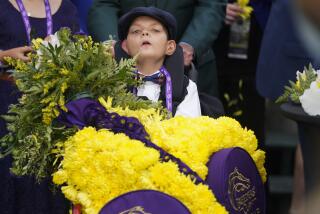The spirit of the Wild West in Cody, Wyo.
Reporting from Cody, Wyo. — Buffalo Bill Cody’s last words were reportedly, “Let my show go on!”
Just a couple hours’ drive east of Yellowstone National Park is the Buffalo Bill Historical Center, less a passing fancy of entertainment than a rich and detailed history lesson that plainly demonstrates that the show about the man — and the myth — is galloping and kicking up dust well into the 21st century.
Like most Americans, I had heard of Buffalo Bill (his bright-lights name was even appropriated by the 1983-84 Dabney Coleman television show, plus that was the nickname for the serial killer in “The Silence of the Lambs.”) But beyond some vague connection to America’s westward expansion in the 19th century, I couldn’t have told you much else. No longer.
Located in the town that bears his name, Cody, Wyo., the Buffalo Bill Museum is actually just one of five museums housed in the same complex that all share the singular purpose of preserving and promoting the spirit of the Old West. From the moment of arrival, visitors are greeted by heroic statues of Cody — one as an upright man with a gun standing on the Plains, another of him on horseback as a scout reading the trail — and they grandly proclaim William Frederick “Buffalo Bill” Cody as the embodiment of the West. (On the day I visited, there was also a Buffalo Bill impersonator welcoming visitors to the museum, and he was quite happy to chat about the bygone days of the West.)
Buffalo Bill Historical Center, 720 Sheridan Ave., Cody, Wyo.; (307) 587-4771, https://www.bbhc.org; adult admission $15, ages 6-17 $10, 5 and younger free.
Cody was born in a log cabin in the then- Iowa Territory and rose to fame and wealth, largely thanks to his globe-trotting Wild West shows. Besides being a showman, he was a soldier and a scout and a Medal of Honor recipient. But as you walk past the artifacts of an astonishingly colorful life — a family Bible, snowshoes, his Stetson hat, an ivory-handled Bowie knife, Sitting Bull’s autograph — you realize that despite the grandeur, not only was daily life in the mid-19th century extraordinarily hard, but also that premature death was all too common.
Cody’s father, an outspoken opponent of slavery, was stabbed in the chest at a pro-slavery rally in 1854, never fully recovered from the wound, and died in 1857, before young Bill was a teenager. Bill also lost two brothers and a half sister during childhood.
But what seems to stand out most about Cody, who earned his nickname for his skills as a hunter and by providing meat for railroad workers, was his knack for showmanship. The museum is stocked with the vibrant and multicolored posters that celebrated the cowboy lifestyle and helped advertise Buffalo Bill’s Wild West shows around the world.
There’s also about a 15-minute loop of old black-and-white film footage taken from the original shows. The snippets include the show’s good-guy-versus-bad-guy reenactments of an attack on the Deadwood stagecoach and the Battle of Summit Springs.
The Buffalo Bill Museum is the complex’s flagship and original inspiration, but it also houses the Whitney Gallery of Western Art, the Plains Indian Museum, the Cody Firearms Museum and the Draper Museum of Natural History. All are stellar additions to the complex, where you can see everything from Albert Bierstadt’s famous paintings of Yellowstone landscapes to a Winchester Model 1894 lever action rifle.
Buffalo Bill, rest easy. Your show and more live on.
More to Read
Sign up for The Wild
We’ll help you find the best places to hike, bike and run, as well as the perfect silent spots for meditation and yoga.
You may occasionally receive promotional content from the Los Angeles Times.






